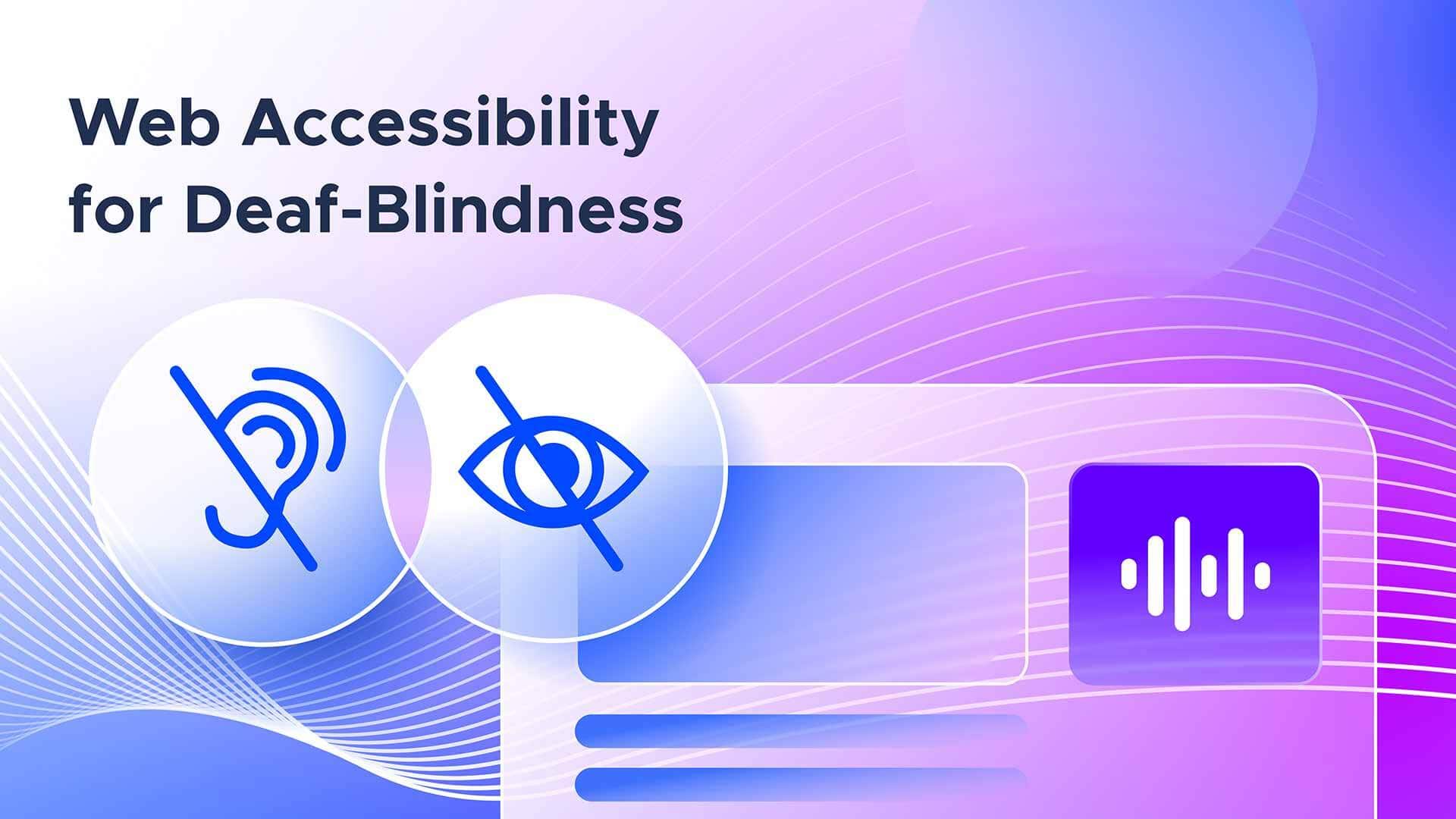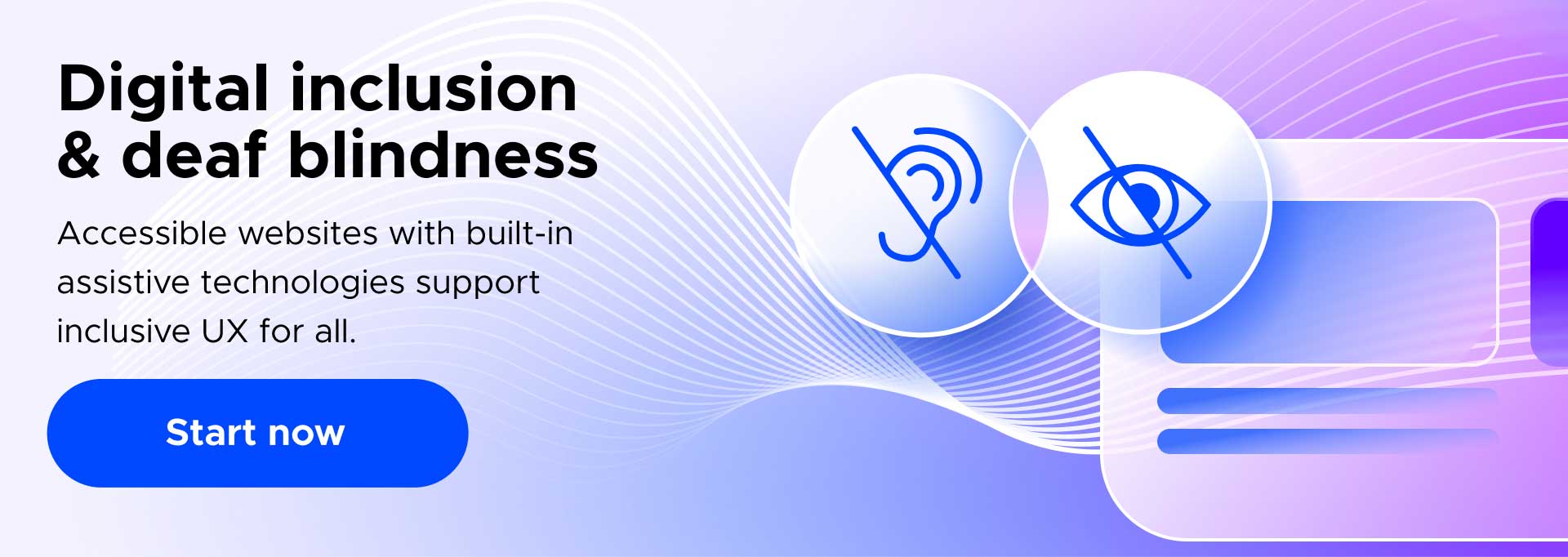Deaf Accessibility & Inclusion for Visual Impairments

Disabilities underpin the need for society to be mindful of the diverse needs, challenges, and experiences faced by people from all walks of life. No one should be prevented from quality-of-life amenities simply because of a limitation. Accommodating individuals with compounding disabilities like deaf blindness means providing various website features for blind and deaf accessibility for an inclusive online user experience. This is especially true as people with visual impairments account for 2% of the world population.
Creating an accessible website for individuals with various degrees of deafness, hearing impairments, or those who fall under the deaf blindness definitions means incorporating a range of digital tools, techniques, and optimizing content for an inclusive experience. Using assistive technologies to create an accessible website involves diverse approaches and methodologies – from keyboard navigation, alt text, captioning and screen readers, to simple language.
Let’s start out by first understanding the deaf blindness community, their needs and the various levels of deaf blindness definition.
Deaf Blindness Definition and Various Causes
According to the National Center on Deaf Blindness (NCBD), individuals within the deaf-blind community experience a certain degree of both vision and hearing loss and are challenged to process information either visually or audibly. While often the case, deaf blindness does not necessarily mean full vision or hearing loss, and also includes individuals with partial loss of both senses, and significant loss of one sense with partial loss of the other.
Causes of Deaf Blindness
More than 70 health complications can be linked to deaf blindness. The most common causes can be linked to syndromes such as; CHARGE, Usher, and Trisomy 13. CHARGE syndrome is the leading cause of deaf-blindness, accounting for 10% of these cases.
Other causes include congenital anomalies and dysfunction, prematurity, and other health events, such as; stroke, meningitis and head trauma. A 2019 NCDB report recorded more than 10,000 cases of deaf blindness in the U.S alone.
Deafness & Hearing Impairment: The Various Levels
The National Association of the Deaf (NAD) helps us understand the ways in which the various levels of deaf people and hearing impaired individuals communicate and integrate in everyday life.
Hard of hearing (HoH): these are individuals who may have specific hearing impairments, but don’t have full hearing loss.
Individuals defined as deaf (lower case ‘d’): these are people who do not see themselves as part of the fully Deaf community, and often means they acquired a hearing impairment at various stages of their life.
Deaf People: individuals defined as Deaf with a capital “D” have full loss of hearing and use sign language to communicate, often born with this level of hearing impairment and have maintained this status throughout their lives.
Blindness & Vision Impairment: The Various Levels
The actual defined level of vision impairment is based on a range of factors like treatment and the ability to prevent conditions, rehabilitating vision capability with assistive aids. Mobility and physical navigation capacity on public transit, within constructions that are inaccessible, and processing data are also factors to consider.
According to the World Health Organization, most levels of vision impairment and blindness are experienced by individuals aged 50+, with the leading cause being uncorrected refractive errors and cataracts. There are at least 2.2 billion individuals with near or distance vision impairment, with nearly half of the cases accounted for being preventable. The various levels of visual impairments and blindness are defined by distance and near vision impairments.
Distance Vision Impairment Levels
Individuals with distance vision impairment experience mild, moderate, severe, or what’s considered full blindness, all of which are based on evaluation of vision capabilities, with numeric definitions listed on the WHO website.
Near Vision Impairment Levels
Near vision impairments are defined with a visual acuity lower than N6 or M.08 at 40cm.
Deaf Accessibility & Vision Impairment Inclusion Online
As most information is processed and learned through sight and sound, deafness and blindness create unique and profound challenges when attempting to use information and communication technology, especially when they appear simultaneously.
Websites are accessible for those with deaf blindness when all visual and audio elements are logically structured and supplemented by at least one other alternative engagement feature. Let’s look at the kind of assistive technology that aids deaf people and blind users, as well as some web accessibility features that ensure barrier-free browsing.
Assistive Tools
Depending on the nature and severity of a condition, for a deaf person or blind individual to use a phone app or website, assistive tools will help accommodate the stronger of their two senses. In the case a person experiences severe or full deaf blindness they will often employ haptic tools to engage in online and digital experiences.
Assistive tools that can help those with deaf-blindness access digital content include:
- Screen reader — Dictates a website or content through auditory cues
- Voice dictation — Allows user with visual impairments users to perform tasks through speech commands
- Braille displays — A device that interprets web and app content onto a live Braille interface
Website Accessibility for Deaf Blindness
To ensure assistive tools are accurately implemented with frictionless functionality, websites should follow specific design and development standards, particularly those outlined in Web Accessibility Content Guidelines (WCAG) published by the World Wide Web Consortium’s (W3C) Web Accessibility Initiative (WAI).
Abiding by WCAG standards will ensure websites and phone apps accommodate assistive technology such as screen readers and braille displays, preventing web developers from building user accessibility barriers. The following features can help ensure your website is accessible to individuals with various degrees of deaf blindness.
1. Keyboard Navigation
Individuals who are vision impaired or blind are unable to orient a cursor with a mouse. Creating a fully accessible website for people with visual impairment ensures it can be navigated with simple keyboard commands and strokes. Hitting ‘Tab’ should move the focus area to the next interactive element, and ‘Enter’ should make selections. Keyboard navigation is an integral tool that enables an inclusive user experience for visual impairments.
2. Well-Structured, Logical Websites
A website designed to be simple, familiar, and logical will provide the best user experience for all users, especially people with varying degrees of deaf blindness who are dependent on assistive tools and technologies. Proper and logical menu structure and use of heading tags will enhance usability for those using keyboard and Braille pad navigation.
3. Image Alt-Text
All images which provide informational value to content must be supplemented with a text-alternative description of the information, also known as alt text. This description is not typically visible to traditional users and can be embedded into an image for screen and Braille readers to process. The alt text should be an accurate verbal representation of what’s included in the image and easy to understand, clearly defining what’s visually included.
4. Accurate Closed Captioning, Transcripts, Sign Language & Quality Audio
Without the addition of closed captioning or available text transcripts, audio of video and other media content is inaccessible for deaf people or have hearing loss. Some organizations provide an accompanying sign language translation feed. With high quality audio and minimized background noise in video content, you can help ensure transcripts and captions are accurate to help people who are deaf and blind to various degrees so they can interact with your web content easily.
5. Various Forms of Contact Outreach & Communication
Creating an accessible communication method beyond telephone is often critical for individuals who are blind and dear or with vision and hearing impairments. Ensure your website includes functions like email or chat communication for inclusion and accessibility of their community. While some deaf people can talk, the hearing limitation makes it crucial to ensure online communication is enabled for an accessible online user experience.
6. ARIA Labels
Accessible Rich Internet Applications (ARIA) labels offer alternative information about interactive elements for screen readers and Braille displays while remaining unseen to sighted users. ARIA labels provide more descriptive details about inherently visual content, such as icons or a form field button, creating a more accessible and inclusive experience for people with visual impairments.
7. Text & Font
Accessible websites don’t limit text size or font displayed to online users, rather they’re structured openly to adapt to a user’s browser settings using an accessibility widget. Some fonts can be difficult to read due to their style or weight, and a user with a visual disability may read another font more easily.
Websites should make it easy to increase text size through on-page settings or a browser. The text should comfortably enlarge up to 200% of its original display size without affecting or impeding on the accessibility of other elements for a frictionless user flow and online experience.
8. Clarity of Content for Anyone Communicating with ASL as their First Language
Keeping the language of your website easy to understand and very clear makes content easier to consume for individuals who use ASL (American Sign Language). Since sign language has its distinct grammar, and individuals with various degrees of deafness may use it as their first language, avoid using any colloquial language, slang, or unclear jargon. Use the active voice (not passive), define terms with simple words, break down content with headers and bullets, and be consistent with word choices throughout the website content.
What are the Benefits of Deaf Blindness Accessibility?
While individuals with deaf blindness make up a small percentage of the disabled community, organizations and developers should note that following WCAG content standards benefits all types and variations of disabilities – visual, hearing, cognitive, and motoric. People with disabilities represent roughly a quarter of the U.S. population, with the Center for Disease Control indicating that 1 out 4 of U.S. citizens have some form of disability or impairment. When disabled users can easily access web content, user engagement, number of viewing sessions, and demand will ultimately be enhanced.
Civil Rights & Accessibility for Deaf Blindness
Designing for accessibility is also ethical and responsible corporate citizenship, and a key component of DEI (Diversity, Equity, and Inclusion). The Americans with Disabilities Act (ADA) was passed in 1990, and establishes the rights of people with disabilities to equal access and opportunity and makes discrimination based on disability a violation of civil rights. According to the U.S. Department of Justice, this includes the right to equal access to websites.
Hosting an accessible website means protecting the rights of the disabled community and will protect your organization from costly litigation and demand letters.
UserWay Makes Accessibility Easy
Creating an accessible website for deaf blindness that’s barrier-free is a technical and creative process that incorporates technology and out of the box thinking. Retrofitting an existing website to adhere to WCAG standards can be extremely timely and expensive. Adding UserWay’s AI-Powered Accessibility Widget is a simple and cost-efficient way to ensure an accessible and inclusive user experience, whether maintaining a small business or enterprise in any stage of growth.
UserWay’s machine learning and human-in-the-loop technology scans for WCAG violations, allowing users to manage and optimize web accessibility and quickly approve remediations. UserWay’s Accessibility Widget provides an on-page accessibility interface that enables user-trigger accessibility preferences, such as text resizing and contrast adjustments.
Frequently Asked Questions
Can people with deaf blindness still access and use the internet?
Yes, though how a deaf person or individual with hearing and vision impairments experiences the internet is unique. People with varying degrees of deaf blindness will depend on different tools and techniques, such as screen readers, keyboard navigation, and dictation. Even a completely deaf person or blind individual can use Braille displays to access websites.
How can I make my website accessible for various degrees of deafness or visually impaired users?
Abiding by WCAG standards (currently WCAG 2.1 & 2.2 AAA) for web accessibility compliance will ensure your website is easy to use for everyone, including those with deaf blindness. AI-powered tools like UserWay’s AI-Powered Accessibility Widget will help detect and remediate accessibility issues that make websites challenging to navigate and use, like missing alt text, inaccurate or lack of closed captions, and/or missing ARIA labels.
Is my business website required to be accessible to people with deaf blindness?
In short, yes. The U.S. Department of Justice’s position is that public-facing websites are subject to Title III of the Americans with Disabilities Act. This act requires accommodations to be made and certain barriers removed to ensure inclusion and equal opportunity for people with disabilities. The DOJ has suggested that businesses follow the Web Content Accessibility Guidelines (WCAG) to comply with the law.





Share